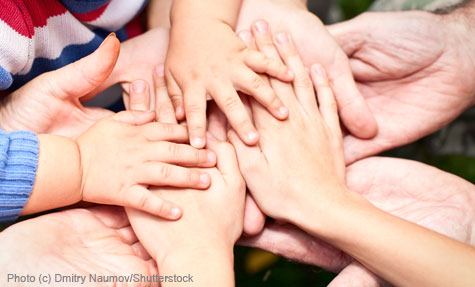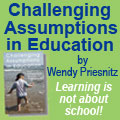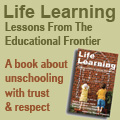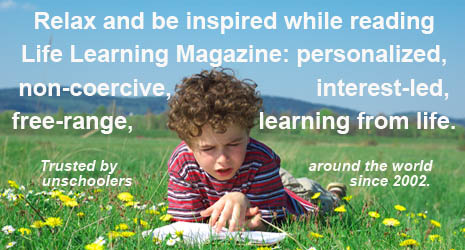|

In the Meantime -
The Process of Helping Children Become Self-Directed
By Jan Fortune Wood
Living by consent requires a commitment to finding solutions, but all too often we are so focused on the end product – the solution – that we can forget to value the process.
When I first made a commitment to try to live in this countercultural way I was very hung up on the notion of non-coercion. Avoiding coercing my children seemed to be the absolute pinnacle of success and it is certainly true that eliminating coercion from family dynamics was helpful.
Children who know that ultimately they will be made to do something no matter how much they have first been listened to are much less willing to participate openly in finding solutions with their parents. Coercion is an unhelpful psychological state to be in – having to do something that goes against the grain of our intrinsic motivation only creates useless inner conflicts.
But the fact is that trying to change our relationships by constantly struggling to avoid coercion is incredibly difficult because it puts us in the position of always thinking negatively. We all know how powerful reverse psychology can be. Telling a toddler on a climbing frame, “Don’t fall!” is invariably tempting the fall to happen simply because we’ve put the idea of falling into the child’s mind. Telling parents, “Don’t coerce” may be just as good advice as “Don’t fall,” but it is similarly fraught with the constant possibility of failure. Trying not to coerce was a big step forward for me in my parenting, but it is ultimately a dead end unless we begin to reverse non-coercion and look instead to positive consent.
Consent is a much more liberating goal to work towards. Instead of assuming that we are constantly in hard situations where the best we can hope for is not to become manipulative or bullying, consent assumes that we can be proactive in our family relationships. We can take the time to learn what works, to build in conversations and opportunities to brainstorm, to reflect on things that haven’t worked well so that we are better prepared for the future.
Consent isn’t about gritting our teeth and letting the three-year-old play with toilet water for fear that coercion will be a worse evil. Rather it’s about engaging with what that three-year-old might want from an experience and working together to find ways to provide a solution that is so much more satisfactory for everyone.
Consent is a whole new positive dynamic. Switching from non-coercion to consent can unblock untold reserves of creativity in both parents and children. But once again there is a note of caution: We live in a very instant world – the Internet delivers virtually instant information; we have a whole range of instant forms of entertainment and even meals can be prepared, if not in an instant, often remarkably quickly. These instantaneous features of modern life can be highly convenient and great value whether as learning or lifestyle tools, but that doesn’t mean that all solutions can or should be instant.
When we engage in finding consent, we are living and educating in a way that is outside the mainstream and we are attempting one of the hardest things possible – to create new ways of thinking and relating. We are aiming high and we shouldn’t be surprised if we don’t always manage it in a two-minute conversation. There are solutions that we make all the time and we can develop short cuts. Choosing what to eat each meal time can be speeded up enormously by knowing about likes and dislikes, keeping available supplies in the house etc. Provided we also allow for change and new ideas, we don’t have constantly to re-invent the wheel. But some solutions are much more demanding than that and we shouldn’t berate ourselves if they take time to solve. There are situations where consent is as much about the ongoing dialog to work towards a solution as it is about the end result solution itself.
Let’s take Stacey. At age sixteen, she decides she wants to become a vet, but up until now she hasn’t done any formal study. The mainstream answer is that it can’t be done, but of course it can. That doesn’t mean that Stacey will have the path completely cleared before her in a week’s time. There will probably be lots of alternative routes to investigate and perhaps some blind alleys as a way forward is worked out over time. The consent here doesn’t require parents to be able to magically ensure that Stacey becomes a vet. Rather it is about finding a way to help with the process, which may mean that at some stage Stacey sees the goal through or that she has to revise the final outcome for something else that will fulfill her intrinsic motivation.
Or take James. At twelve, he is already an outstanding tennis player. His family is far from rich, but they have worked hard to ensure that family finances allow for his lessons and equipment. James is getting on well, but he’s ambitious and tennis means a great deal to him. He especially wants a particular racquet that his parents think is just a stretch too far for the family budget. However they agree that there will be a way to work it out – it may take several months, but with some saving and re-adjustments the racquet can be bought. The family sits down and goes through the finances together – James included – each offering ideas on things that can be cut back or postponed for a while to save the money that is needed.
The solution isn’t instant, but the commitment to work towards a solution can be every bit as important as being able to come up with a solution immediately. Making a commitment to live by consent doesn’t make us richer or impart ready-made genius at problem solving, but it re-orients how we think about one another so that there is a new dynamic in which the process of problem solving is valued in itself.
No doubt James would really love the racquet as soon as possible and it might be that there are times when the request can be met or a garage sale can speed up the waiting. On the other hand there may be times when the longed-for racquet takes even longer to get and consent is still achieved; if the family car breaks down, then James is highly likely to value a new one more than a racquet because above all else he wants to be able to get to his lessons and keep improving his game. It might even be that after sitting down and brainstorming James decides that the racquet isn’t so important in the next few months because he doesn’t want to miss out on a family holiday or having take-out meals on Friday nights.
The key point is that it is our serious engagement in finding a solution that matters, whatever the solution ends up being. This isn’t an opt-out clause. Many of us who are parents probably grew up with requests being met by vague “holding” answers that we knew from a young age were just a way for parents to dismiss us without having to actually say no. “Can I have a new bike?” was met with, “Well, we’ll have to see…” or “Can I go to Janie’s party?” might have been brushed off with, “Maybe. Let’s see how things go.” These ambiguously-phrased responses are veiled negatives that make no attempt to find solutions and children know it.
That’s not territory we want to get into, but neither do we want to get into a position in parenting where we feel that we should always be able to snap our fingers and provide like fairy godmothers. Finding solutions is not the business of granting wishes. Instead we are engaged in finding ways to seriously engage with what our children want and find ways to meet their intrinsic motivation. That will sometimes mean simply agreeing and will sometimes mean a long process of brainstorming and working towards a goal, which may or may not be the one first asked for.
As consent-seeking parents, our catch phrase is not “we’ll see,” but “in the meantime” – that is, for as long as a solution is not yet found we’ll keep on working at it, taking the issue seriously, and pooling our creativity until we’re all satisfied. In consent, the process of finding the solution is at least as important as the solution.
Jan Fortune Wood lives and works in Wales, UK as a freelance writer, poet, publisher, parenting advisor and humanist liturgist (developing ceremonies and rites of passage.) She is author of four titles on home education, autonomous education and non-coercive parenting. (Doing It Their Way; Without Boundaries; Bound To Be Free and With Consent, all published by Educational Heretics Press). She home educated her own four children.
Copyright © Life Media
Privacy Policy
  
  

|

